Here are the new Radeon RX 580 graphics cards
A roundup of the newly launched RX 580 cards from AMD's hardware partners.
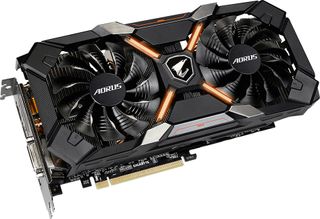
AMD today launched its Radeon RX 500 series of graphics cards built around a refined version of its Polaris architecture. These new cards feature higher clockspeeds and perform better than the RX 400 series they're replacing. How much faster? We have plenty of benchmarks and in-depth analysis of the RX 580 and RX 570.
We've also scoured the web for new cards based on AMD's top-end Radeon RX 580 part, and it turns there are quite a few of them. Like the RX 480, these come in 4GB and 8GB varieties. Suggested retail pricing is $229 for the 8GB models and $199 for the 4GB models, though custom cooling solutions and factory overclocks will inevitably lead to a variety of price points as these trickle into retail.
We plan to keep this page updated with new models as they're announced. Add it to your bookmarks and check back often if you to stay up to date with what's available.
Aorus
Gigabyte is one of AMD's most active partners in the graphics card space, in part because it's balancing two brands—its own Gigabyte name and Aorus, the company's gaming division.
Starting with Aorus, there are three Radeon RX 580 cards on tap. Shown up top is the Radeon RX 580 XTR 8G (GV-RX580XTRAORUS-8GD). It is the fastest of the bunch, though Aorus isn't super clear in what frequencies it's listing. The product page shows the "core clock" set at 1,425MHz in Gaming mode and 1,429MHz in OC mode, which Aorus compares to 1,340MHz for a "reference card." That reference clockseep is actually the boost clock, whereas AMD's reference base frequency is 1,257MHz. That leads us to believe Aorus is posting boost clocks.
In any event, the card also features Gigabyte's Windforce cooling solution with two 100mm fans, a large aluminum block with heatpipes running through, and a backside cooling module. And of course there is the requisite RGB lighting.
Display outputs consist of three DisplayPorts, an HDMI connector, and a DL-DVI-D connector. The card draws power from a single 8-pin PCIe connector.
The biggest gaming news, reviews and hardware deals
Keep up to date with the most important stories and the best deals, as picked by the PC Gamer team.
Aorus also offers two other Radeon RX 580 graphics cards. One is a 4GB model (GV-RX580AORUS-4GD) with a slightly different Windforce cooler, 1,365MHz boost clock in Gaming mode, and 1,380MHz clock in OC mode, and an 8GB version (GV-RX580AORUS-8GD) of the same card with the same clockspeeds. They both have the same collection of display outputs and both require a single 8-pin PCIe connector.
Gigabyte
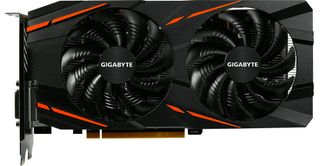
Gigabyte also offers two Radeon RX 580 cards under its own branding, the Gigabyte Radeon RX 580 Gaming 8G (GV-RX580GAMING-8GD) and Radeon RX 580 Gaming 4G (GV-RX580GAMING-4GD). The cards are the same except for amount of RAM and accent coloring on the cooling shroud.
Assuming Gigabyte is listing boost clocks, both cards stick to reference in Gaming mode (1,340MHz), while bumping things up to 1,355MHz in OC mode.
Both cards also feature Gigabyte's Windforce 2X cooling solution with two 90mm fans, and customizable RGB lighting.
Like the Aorus cards, these have three DisplayPorts, along with HDMI and DL-DVI-D outputs, and draw power from a single 8-pin PCIe plug.
Powercolor
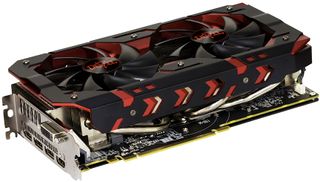
Powercolor is another active partner of AMD's with no less than four Radeon RX 580 cards to kick things off. Shown above is Powercolor's fastest model, the long-winded Red Devil Golden Sample Radeon RX 580 (AVRX 580 8GBD5-3DHG/OC) with 8GB of GDDR5 memory.
Like Gigabyte/Aorus, Powercolor doesn't bother to mention core clocks, and instead lists a boost clock of up to 1,425MHz. It also has a custom cooling solution and draws power from 6-pin and 8-pin PCIe connectors. Display connectors include three DisplayPort, one HDMI, and one dual-link DVI-D.
Powercolor's three other RX 580 models are all Red Dragon variants. One is an 8GB version of the Golden Sample (AVRX 580 8GBD5-3DH/OC) that uses the same color but with slower clocks (up to 1,380MHz). It offers the same display connections and power plug requirements.
The last two are 8GB (AVRX 580 8GBD5-3DHD/OC) and 4GB (AVRX 580 4GDB5-3DHD/OC) models with different cooling solutions, both with a boost clock of up to 1,350MHz. These have the same display inputs, but require just a single 8-pin PCIe connector.
Sapphire
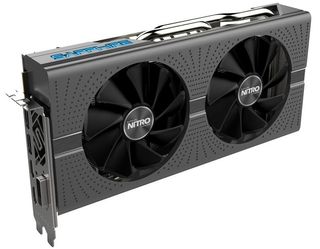
Arguably one of the nicest looking RX 580 cards out there is the Sapphire Nitro+ Radeon RX 580 8GD5 Limited Edition model. It is one of five RX 580 cards from Sapphire, and the only limited edition variant. The distinction there is that the limited edition SKU boasts cherry picked GPUs that have been tested for a higher level of performance.
These cards have a boost clock of up to 1,450MHz and use high-end parts, such as "Black Diamond Choke 4" chokes that Sapphire says are 10 percent cooler and 25 percent more power efficient than a normal choke.
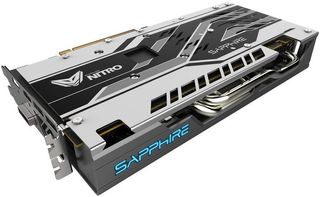
The stylish cooling solution has a gunmetal finish with a large backplate, shown above. Dual ball bearing fans and heatpipes help cool the GPU, and of course there is RGB lighting, though it's not overdone.
Display outputs consist of a DVI-D port, two HDMI ports, and two DisplayPort 1.4 ports. It draws power from 8-pin and 6-pin PCIe connectors (one each).
Sapphire offers two other 'regular' Nitro+ models, one with 8GB of memory (Nitro+ Radeon RX 580 8GD5) and one with 4GB (Nitro+ Radeon RX 580 4GD5). Both are clocked at up to 1,411MHz (boost) and use high-end parts like the limited edition SKU, but sport a different looking cooling shroud. The GPUs aren't cherry picked either, though these cards are still factory overclocked. They also have the same display outputs and power connector requirements.
Finally, Sapphire offers two Pulse models, the Pulse Radeon RX 580 8GD5 and Pulse Radeon RX 580 4GD5. These have boost clocks of 1,366MHz. They also use high-end components like the rest of the lineup. In a nutshell, they're slower clocked variants with a different looking cooling solution and lower power requirements (they take just a single 8-pin PCIe connector).
MSI
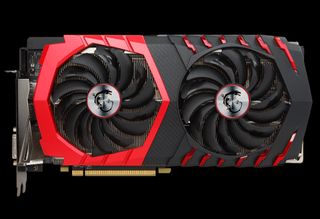
MSI also came ready to rock with five Radeon RX 580 graphics cards. Pictured above is the Radeon RX 580 Gaming X+ 8G. It operates in three modes—Silent (1,411MHz boost), Gaming (1,431MHz boost), and OC (1,441MHz boost). The memory is clocked at 8,000MHz (effective) in Silent and Gaming, and 8,100MHz in OC mode.
Cooling is handled by MSI's Twin Frozr VI cooler, which has two Torx 2.0 double ball bearing fans, 8mm thick heatpipes, and a copper baseplate.
Connectors consist of two DisplayPort and two HDMI outputs, and a dual-link DVI-D option. The card draws power from two 8-pin connectors.
MSI offers this same card in non-X+ variants (Radeon RX 580 Gaming X 8G and Radeon RX 580 Gaming X 4G). Both are clocked at 1,340MHz in Silent mode, 1,380MHz in Gaming mode, and 1,393MHz in OC mode. The 8GB model also features the same memory clocks as the X+ card, while the 4GB model drops down to 7,000MHz in Silent and Gaming modes, and 7,100MHz in OC mode.
Display connectors are the same (two DisplayPort, two HDMI, and one DL-DVI-D), while power is drawn from a single 8-pin PCIe connector.
The last two cards in MSI's RX 580 lineup are both Armor edition SKUs available in 4GB and 8GB flavors. MSI's 8GB model has a 1,366MHz boost clock and 8,000MHz memory frequency, while the 4GB model drops the GDDR5 frequency down to 7,000MHz.
As with other Armor cards, these ship with a spiffy looking black and while cooling solution with two fans. It doesn't cover the whole card, so parts of the PCB are visible.
Asus
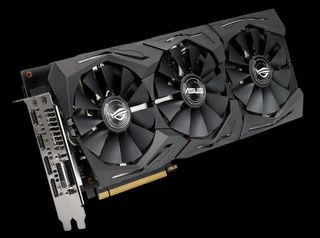
Asus has given AMD's new cards the ROG Strix treatment, starting with the ROG Strix Radeon RX 580 Top edition card with 8GB of GDDR5 memory shown above. It's one of four new RX 580 cards Asus announced.
Living up to its "Top" moniker, the Top edition is the fastest of the four. It's aggressively overclocked to 1,411MHz (boost) in Gaming mode, and 1,431MHz in OC mode.
The card has a three-fan cooling solution with a large aluminum block underneath. It's constructed with a 2.5-slot width to provide 40 percent more heat dissipation area. According to Asus, that translates into up to 30 percent cooler temps than reference, while running three times quieter.
There is also a non-Top version (ROG Strix Radeon RX 580 OC) with the same 8GB of GDDR5 memory and same cooling solution. However, the clocks are set a little less aggressively at 1,360MHz in Gaming mode and 1,380MHz in OC mode.
Both cards offer up a native DVI-D port, two HDMI 2.0 ports, and two regular DisplayPorts, and draw power from a single 8-pin PCIe connector.
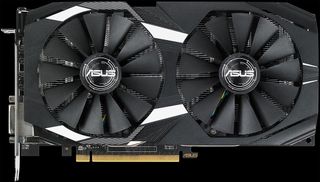
The last two SKUs on the list from Asus are the Dual Radeon RX 580 and Dual Radeon RX 580 OC, both with 4GB of GDDR5 memory. The links to their products pages don't seem to be working at the moment, but according to the company's press release, they feature two-fan cooling solutions that resist dust and only spin up as needed.
As for clockspeeds, the OC model runs at 1,360MHz in Gaming mode and 1,380MHz in OC mode, while the standard edition is set at 1,340MHz in Gaming mode and 1,360MHz in OC mode.
XFX
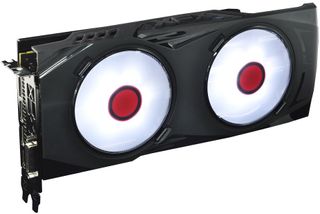
In case you don't have enough Radeon RX 580 options to choose from, XFX brought 10 more to the party. That's right, XFX is offering up 10 different SKUs.
Shown above is the Radeon RX 580 GTR XXX Edition 8GB White - Best Buy, which we take to mean is an exclusive model for Best Buy locations. It runs at 1,366MHz at stock settings and 1,386MHz in OC mode.
As the name implies, this uses white fan blades, with a red center. It's a dual fan cooling solution that is not wholly unique—as with several other cards, there is a large aluminum block that runs the length of the card, with heatpipes snaking through.
This one takes both 6-pin and 8-pin PCIe connectors (one each) and offers up three DisplayPorts, and HDMI output, and a DL-DVI-D connector.
Among the other nine cards are two 4GB models and seven 8GB SKUs with varying clockspeeds and color options. Rather than detail each one individually (you can check them all out here), we'll skip straight to the fastest two—the Radeon RX 580 GTR-S Black Edition White and Radeon RX 580 GTR-S Black Edition 8GB Crimson.
The GTR-S Black Edition models have boost clocks that go up to 1,430MHz at stock and 1,450MHz in OC mode. That ties them with Sapphire's Nitro+ Limited Edition card for the speed crown. They also bump the memory from 8,000MHz to 8,100MHz in OC mode.
These cards have the same cooling solution, display outputs, and power connector requirements of as the GTR XXX Edition.
Paul has been playing PC games and raking his knuckles on computer hardware since the Commodore 64. He does not have any tattoos, but thinks it would be cool to get one that reads LOAD"*",8,1. In his off time, he rides motorcycles and wrestles alligators (only one of those is true).
Most Popular






